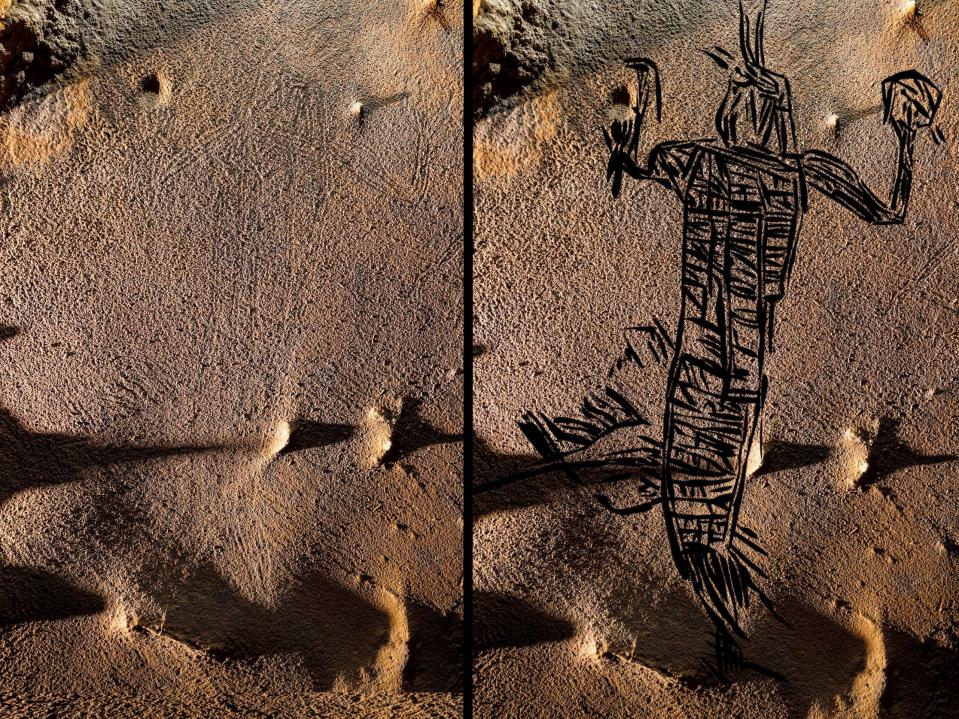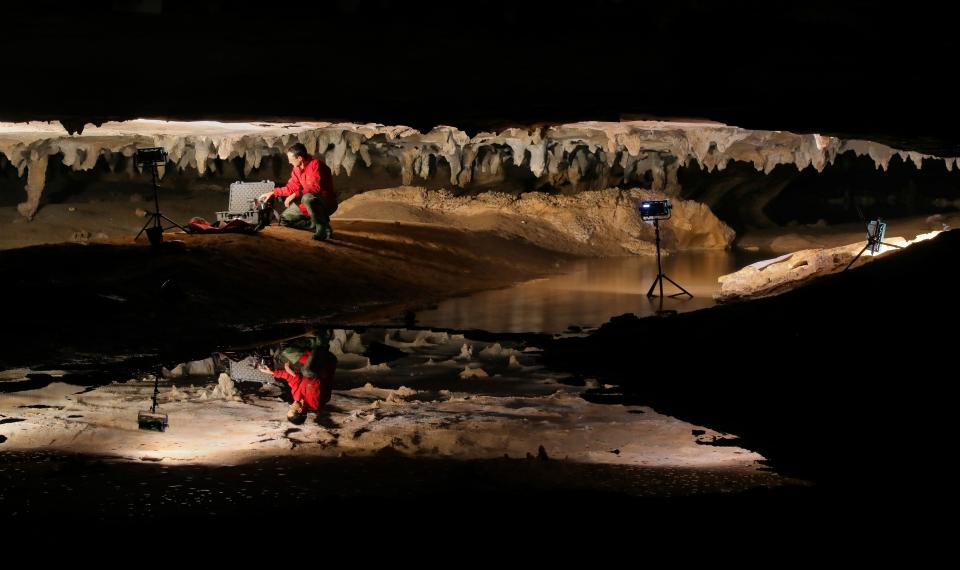Scientists use 3D technology to uncover largest collection of ancient Native American cave art
4 min readResearchers utilised 3D scanning know-how to expose what they say is the premier collection of cave artwork drawings ever located in North America.
Among the glyphs found out on the ceiling of a cave in Alabama is a serpent-shaped determine that steps about 11 ft, researchers noted in analysis published Wednesday in the peer-reviewed journal Antiquity.
The five examples of Native American cave art documented in the research had been the premier discovered and believed to be 1,000 to 1,800 many years outdated, said co-creator Jan Simek, an archaeologist and professor of anthropology at the University of Tennessee. But the system made use of to build a photorealistic, virtual 3D model of the cave really disclosed “hundreds of extra glyphs and visuals,” in accordance to a story documenting the research in the Historic Artwork Archive.
“It was stunning to see them, but it wasn’t astonishing they were being there,” Simek informed United states of america These days.
Which is due to the fact archaeologists have identified several examples of open-air rock art established prior to Spanish explorers arrived in North The usa. But a great deal of that has been observed by archaeologists discovering burial websites.

Arizona arrest: 40-year-previous father arrested after using element in struggle at son’s high faculty
‘I go through banned books’: Tennessee library releases a library card to fight guide bans
These new revelations come right after Simek – a board member of the non-earnings archive – and analyze co-author Alan Cressler to start with posted findings in 1999 about the cave, discovered as “19th Unnamed Cave” to guard its location from looters. Just after Cressler subsequently found some additional faint mud drawings in the cave’s ceiling, they determined to examine additional.
To correctly seize the ceiling’s topography, the study’s third co-creator Stephen Alvarez, who is also a founder of the Ancient Art Archive, proposed the 3D mapping venture. He expended a number of months getting additional than 16,000 high-resolution photos in the much more than 5,000-sq.-foot chamber.
Individuals overlapping photographs have been stitched jointly into a 3D design employing photogrammetry, a software package technologies also utilized in building digital maps and environments, and digital objects for video online games these kinds of as Connect with of Duty.
Alvarez also built a personalized laptop or computer to deal with the processing following one computer’s motherboard melted whilst compiling the visuals.

Within just the potent 3D software, the experts could glow digital light on the ceiling’s floor to expose formerly unseen drawings. A lot of etchings were faint or obscured as humidity and rain had worn them away, the scientists reported.
The 3D design also offered a superior vantage issue for evaluating the cave surface area because “the limited actual physical confines of the cave” required you to crouch or be prone to look at it in individual, they stated. As a consequence, you are typically way too close to the ceiling to discern pictures. “We can truly fall the floor absent from the ceiling in the design,” Simek advised Usa Right now.
What is actually all people talking about? Sign up for our trending e-newsletter to get the latest information of the day
The authentic cave artists made these lifestyle-sized and larger sized drawings “without having remaining in a position to see them in their entirety,” the researchers wrote in Antiquity. “Therefore, the makers worked from their imaginations, instead than from an unimpeded visible perspective.”
What were they basically drawing? Due to the fact caves were being sacred sites to Native Americans of the Southeast U.S. – and regarded as “pathways to the underworld,” the researchers publish – the stylized human kinds, depicted below with rattlesnakes, may depict religious spirits.
“We would characterize them as human-like types, but it is tough to notify whether or not they are human beings in elaborate regalia or probably supernatural characters,” Simek mentioned. “Which means is tough this considerably into the past.”
Historical artwork in caves was unanticipated by numerous archaeologists, he mentioned. “We were enthusiastic to see these points arise via the process of this analytical approach,” Simek reported.
The scientists have revealed the conclusions to the Jap Band of Cherokees’ yearly archaeology conference. “They ended up really fascinated by what we ended up seeing,” Simek claimed.
The Cherokee Nation, alongside with the Muscogee Creek Nation, the Chickasaw Country, and the Choctaw Country, are among the the tribes whose descendants lived in the region at the time the drawings were produced.
Photogrammetry has subsequently been employed in several other caves in the Southeast. “What amazes me about working with 3D modeling is that a story that was laid down a thousand moreover many years back and has been invisible can now be seen in its entirety,” Alvarez stated.
“The artists who engraved the cave are speaking to us,” he reported. “We can use 3D modeling to pay attention.”

Comply with Mike Snider on Twitter: @mikesnider.
This posting at first appeared on United states of america These days: Alabama cave’s historical drawings uncovered by electronic scan technologies







